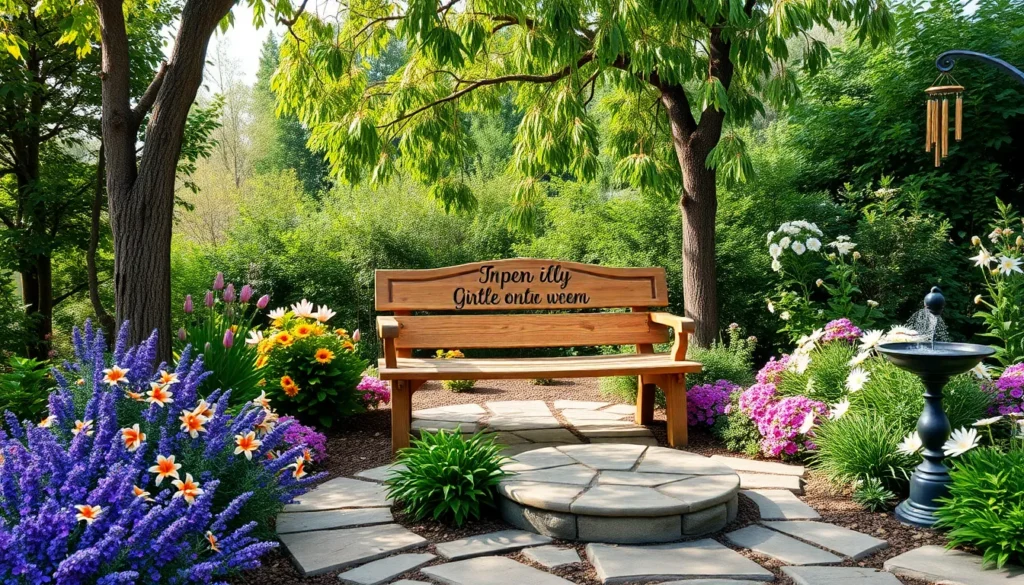Creating a memorial garden transforms grief into something beautiful—a living tribute that honors our loved ones while providing comfort for years to come. These sacred spaces offer us a peaceful retreat where memories bloom alongside flowers and meaningful elements create lasting connections to those we’ve lost.
We’ve discovered that the most touching memorial gardens blend personal touches with thoughtful design elements. Whether you’re planning a small corner of your backyard or designing an entire industry dedicated to remembrance, the right combination of plants, features, and symbolic elements can create a space that truly reflects your loved one’s spirit.
From choosing perennial flowers that return each season to incorporating meaningful stones, benches, or water features, countless possibilities exist for crafting a memorial garden that speaks to your heart. Let’s explore inspiring ideas that’ll help you create a beautiful sanctuary where love and memories can flourish together.
Choose a Meaningful Location for Your Memorial Garden
Selecting the right spot for your memorial garden sets the foundation for creating a lasting tribute that brings peace and comfort for years to come.
Consider Privacy and Tranquility
Find a secluded corner of your property where visitors can reflect without distractions from daily activities. We recommend choosing areas away from high traffic zones like driveways, playgrounds, or busy walkways where noise might interrupt moments of remembrance.
Create natural barriers using existing landscaping features such as mature trees, hedges, or garden walls that provide both visual screening and wind protection. These elements help establish the intimate atmosphere that makes memorial gardens feel sacred and separate from everyday spaces.
Look for naturally quiet spots that already possess a sense of calm, such as the far end of your backyard or a side yard that receives minimal foot traffic. Areas near water features like ponds or fountains can also enhance the peaceful ambiance while masking unwanted neighborhood sounds.
Evaluate Sunlight and Soil Conditions
Assess the daily sun patterns in potential locations throughout different seasons, as most memorial garden plants require at least 6 hours of direct sunlight for optimal growth. We suggest observing your chosen spot at various times during spring and summer to understand how shadows shift with the sun’s path.
Test your soil quality using a simple pH testing kit from your local garden center, aiming for a pH level between 6.0 and 7.0 for most flowering plants and shrubs. Poor drainage can kill memorial plantings, so check how water behaves after heavy rain by digging a small hole and filling it with water.
Consider the mature size of trees and structures that might create future shade problems as they grow larger over time. Locations that receive morning sun but afternoon shade often work well for memorial gardens, as they protect delicate blooms from harsh midday heat while still providing adequate light for healthy plant development.
Think About Accessibility for Visitors
Ensure easy walking access from your home’s main entrance or driveway, especially for elderly family members or those with mobility challenges who want to visit the memorial space. We recommend creating clear pathways using stepping stones, gravel, or paved walkways that remain safe and navigable in all weather conditions.
Plan for comfortable seating by choosing locations where you can easily install benches, chairs, or small garden stools without disrupting the overall design flow. Areas with level ground make it simpler to place permanent seating elements that invite visitors to stay and spend time in quiet reflection.
Consider maintenance accessibility for ongoing garden care, ensuring you can reach all planted areas with a hose for watering and have space to maneuver with basic gardening tools. Memorial gardens require regular tending to maintain their beauty, so choose spots where routine tasks like weeding, pruning, and seasonal planting feel manageable rather than burdensome.
Select Plants That Hold Special Significance
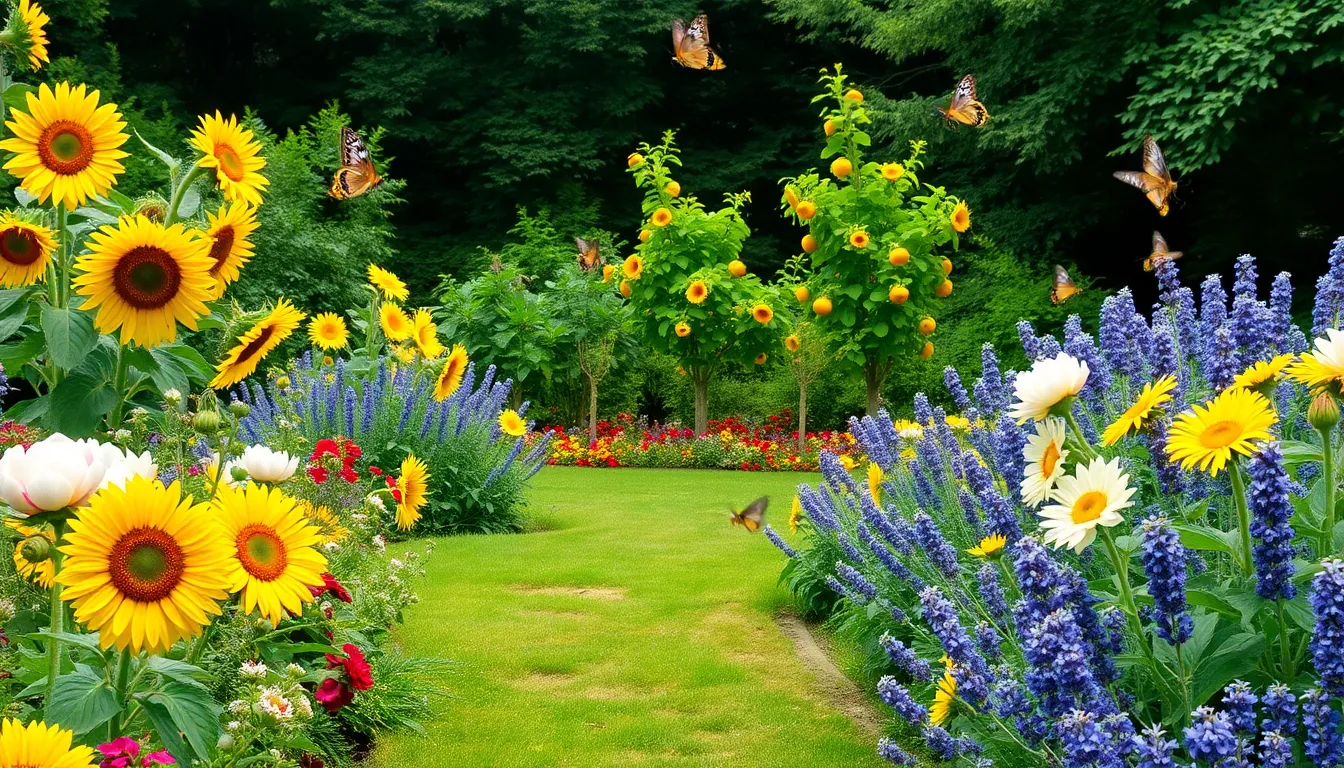
We can create deeper meaning in our memorial garden by choosing plants with symbolic value that reflect our loved one’s spirit. Research shows that incorporating plants with cultural or emotional significance adds layers of remembrance to these sacred spaces.
Incorporate Their Favorite Flowers
We should start by planting the exact flowers our loved one cherished most during their lifetime. Whether they preferred vibrant sunflowers that brightened their kitchen table or delicate peonies that bloomed in their childhood home, these personal favorites become living tributes to their memory. We can include ornamental varieties like roses and daffodils, or even expand to their favorite vegetables such as tomatoes and herbs they used for cooking. Some families discover that their departed loved one had a passion for fruit trees like apple or cherry varieties, which we can incorporate as beautiful focal points that also provide seasonal beauty and wildlife habitat.
Choose Perennials for Lasting Beauty
We recommend selecting perennial plants that return year after year, ensuring our memorial garden maintains its beauty with minimal ongoing maintenance. Daylilies offer vibrant colors throughout summer months while requiring little care once established. Hostas provide lush foliage in shaded areas and produce elegant flower spikes in late summer. Lavender brings both visual appeal and fragrance while attracting beneficial pollinators to the garden space. These hardy perennials create a sustainable foundation that honors our loved one’s memory through seasons of renewal and growth.
Add Fragrant Herbs for Sensory Memories
We can enhance our memorial garden’s emotional impact by including aromatic herbs that trigger positive memories through scent. Lavender releases its calming fragrance when brushed against, often reminding visitors of peaceful moments shared with their loved one. Rosemary provides year round greenery and releases its distinctive aroma when touched, symbolizing remembrance in many cultures. Mint varieties spread naturally and offer fresh scents that can evoke memories of shared meals or garden walks together. These fragrant plants serve dual purposes by attracting butterflies and bees while creating sensory experiences that connect us emotionally to cherished memories.
Create a Focal Point With Memorial Elements
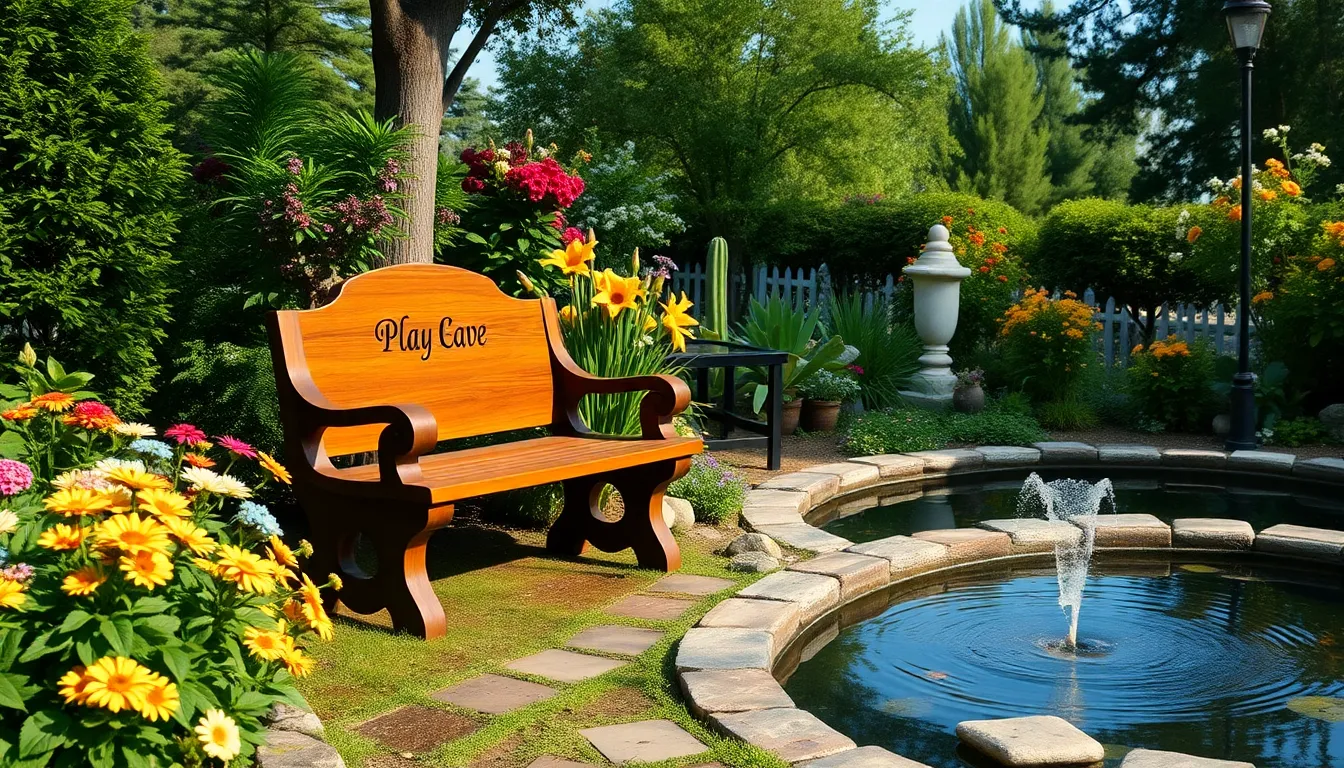
Every memorial garden benefits from a central element that draws the eye and anchors the space emotionally. These meaningful features serve as gathering points for reflection while honoring your loved one’s memory.
Install a Memorial Bench or Seating Area
Benches provide visitors with a comfortable space to sit and reflect while creating an inviting atmosphere within your memorial garden. Garden swings offer an alternative seating option that adds gentle movement and can evoke peaceful childhood memories. We recommend positioning these seating elements near the most serene areas of your garden to maximize their contemplative value.
Consider these seating options for your memorial space:
- Engraved wooden benches with personalized messages or dates
- Stone benches that blend naturally with garden landscaping
- Garden swings suspended from sturdy tree branches
- Curved benches that encourage conversation among multiple visitors
Add a Memorial Stone or Plaque
Engraved plaques and stones create permanent commemorative elements that can be personalized with names, meaningful dates, or favorite quotes from your loved one. These durable memorial pieces withstand weather conditions while serving as lasting tributes. We suggest selecting materials like granite, bronze, or natural stone that complement your garden’s overall aesthetic.
Popular memorial stone options include:
- Flat memorial stones embedded directly into walkways
- Upright granite markers positioned near favorite plants
- Bronze plaques mounted on natural boulders
- Engraved stepping stones that create memorial pathways
Include a Water Feature for Peaceful Sounds
Small ponds and fountains enhance the serene ambiance of memorial gardens through the soothing sound of moving water. These features create a peaceful atmosphere that encourages quiet contemplation and meditation. We find that even modest water elements like bubbling rock fountains can transform the entire mood of a memorial space.
- Recirculating fountains with gentle water flow
- Small reflecting ponds that mirror the sky
- Wall mounted water features for compact spaces
- Solar powered fountains that operate without electrical connections
Design Pathways and Garden Structure
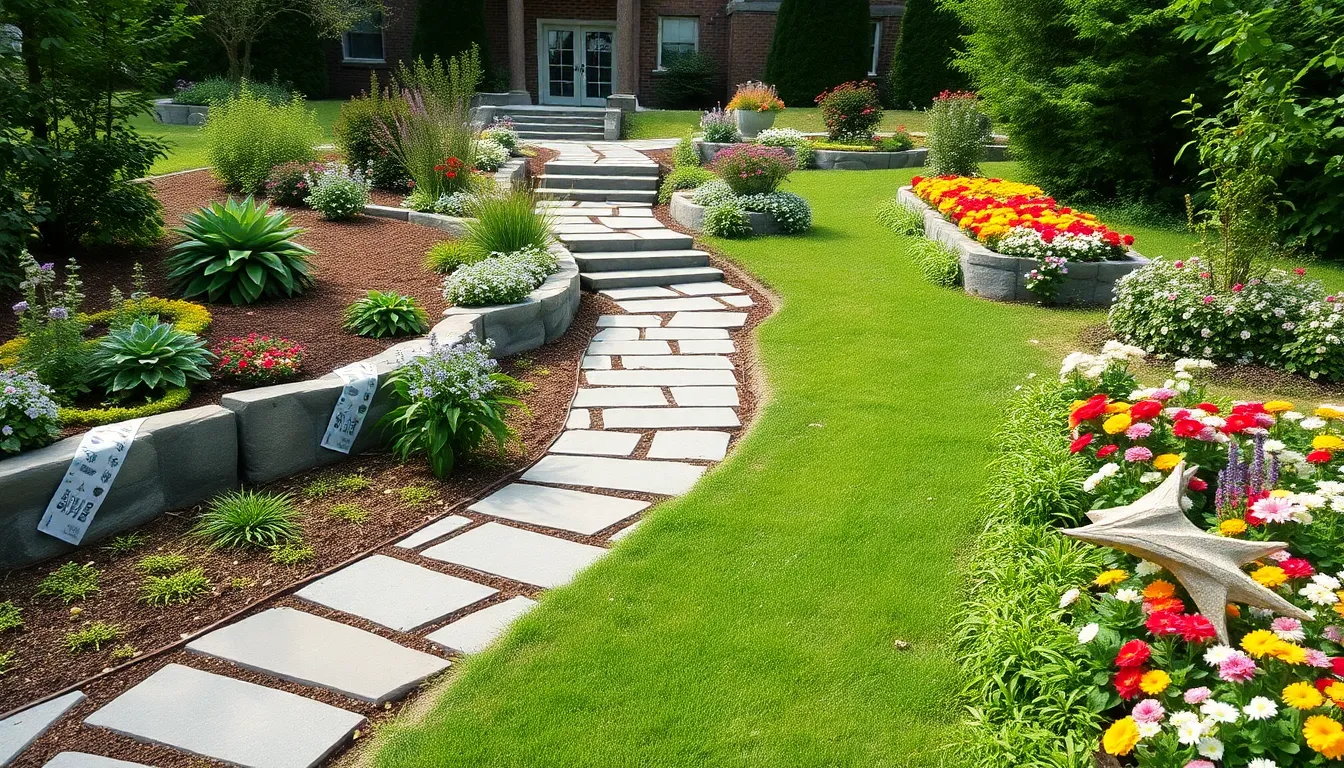
Thoughtful pathway design creates the foundation for a meaningful memorial garden experience. We’ll explore how strategic structural elements can transform your space into a peaceful sanctuary for reflection and remembrance.
Create Winding Paths for Contemplation
Meandering pathways invite visitors to slow down and reflect as they move through your memorial garden. Natural materials like stone, wood, or brick create rustic and serene ambiance that enhances the contemplative atmosphere. Stone pathways offer durability and timeless appeal, while wooden walkways provide warmth and blend seamlessly with garden surroundings.
Curved paths naturally encourage a meditative pace, allowing visitors to pause at meaningful spots throughout the garden. Brick pathways create classic charm and can incorporate patterns or designs that hold special significance. Wide enough paths accommodate wheelchairs and walkers, ensuring accessibility for all visitors who wish to pay their respects.
Define Garden Borders With Natural Materials
Natural borders create cohesive garden sections while maintaining the organic feel essential to memorial spaces. Wood, stone, and plants work together to establish defined areas without harsh artificial barriers. Stone borders provide permanent structure and complement the natural industry beautifully.
Wooden borders offer flexibility and can be customized to match your garden’s aesthetic preferences. Plant borders using shrubs, ornamental grasses, or perennial flowers create living boundaries that evolve with the seasons. Mixed material borders combine different natural elements for visual interest and textural variety.
Strategic border placement separates different garden areas while maintaining visual flow throughout the space. These natural dividers help organize memorial elements like seating areas, plant collections, and decorative features into meaningful zones.
Add Raised Beds for Easy Maintenance
Raised beds simplify garden care while creating opportunities to showcase meaningful plants and flowers. These elevated planting areas reduce bending and kneeling, making maintenance accessible for visitors of all ages and abilities. Customizable height options accommodate different physical needs and gardening preferences.
Memorial gardens benefit from raised beds filled with the deceased’s favorite flowers, herbs, or vegetables. Perennial plantings in raised beds ensure lasting beauty with minimal annual replanting requirements. Seasonal flower rotations keep the garden vibrant and provide ongoing opportunities for meaningful tributes.
Raised bed materials like stone, wood, or composite materials complement your garden’s overall design aesthetic. Proper drainage systems in raised beds promote healthy plant growth and reduce maintenance concerns. Strategic placement of raised beds creates natural gathering points for reflection and remembrance activities.
Incorporate Personal Touches and Remembrances
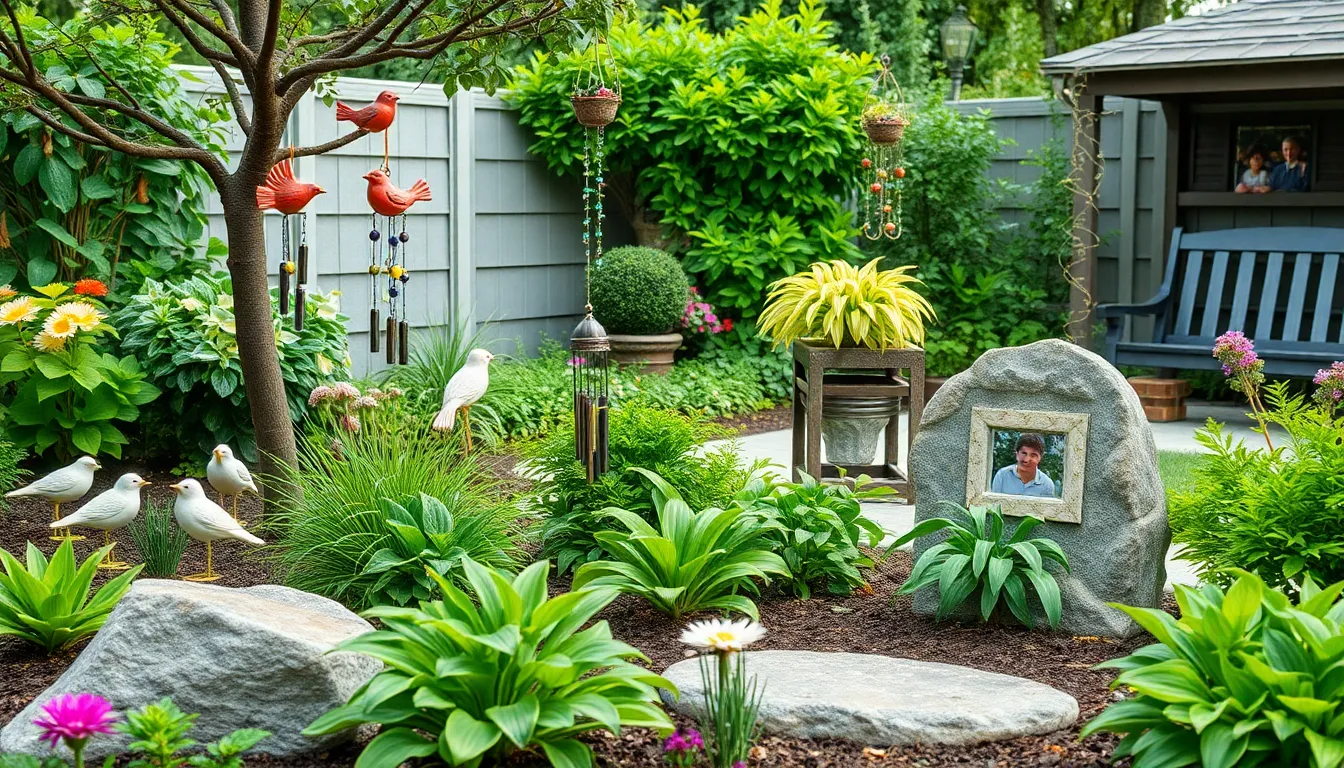
Beyond the foundation of thoughtful design and meaningful plants, we can transform our memorial garden into a deeply personal sanctuary by incorporating elements that celebrate the unique spirit of our loved one. These personal touches create lasting connections between visitors and cherished memories.
Display Meaningful Garden Ornaments
Garden art pieces serve as powerful focal points that reflect the personality and interests of those we remember. We can select sculptures, wind chimes, or decorative elements that mirror their hobbies and passions, such as ceramic birds for nature enthusiasts or musical wind chimes for music lovers.
Engraved plaques offer permanent tribute spaces where we can display special messages, favorite quotes, or simply their name and dates. Solar powered lights provide gentle illumination for evening visits while highlighting these meaningful ornaments throughout the garden.
Weatherproof frames allow us to display cherished photographs that capture joyful moments and celebrate their life. We position these frames near seating areas or along pathways where visitors can pause and reflect on shared memories.
Plant a Memorial Tree as a Living Tribute
Memorial trees create enduring symbols that grow stronger with each passing year, mirroring how our love continues to flourish. We select trees based on their symbolic meaning, choosing willows for their graceful flexibility or oaks for their representation of strength and endurance.
Tree plaques attached to the trunk or positioned nearby provide permanent identification and can include meaningful messages or dates. Fruit trees offer the added benefit of providing nourishment for wildlife while creating beautiful seasonal displays through blossoms and harvests.
Evergreen varieties ensure year round presence in the garden, maintaining their beauty through all seasons just as our memories remain constant. We consider the mature size of our chosen tree to ensure it complements the overall garden design without overwhelming other elements.
Create a Memory Box or Time Capsule Area
Hidden compartments integrated into garden design provide secure spaces where visitors can leave notes, photos, or small mementos over time. We can incorporate these storage areas within decorative stones, beneath memorial benches, or as part of raised planting beds.
Reflective spaces surrounding these memory areas encourage contemplation and provide comfortable spots for visitors to spend quiet moments. Nearby seating allows family and friends to sit peacefully while adding their own remembrances to the collection.
Weather resistant containers ensure that stored items remain protected from the elements while maintaining easy access for those who wish to contribute. We design these areas to blend naturally with the surrounding industry, creating an organic integration that feels intentional rather than intrusive.
Plan for Seasonal Interest and Year-Round Beauty
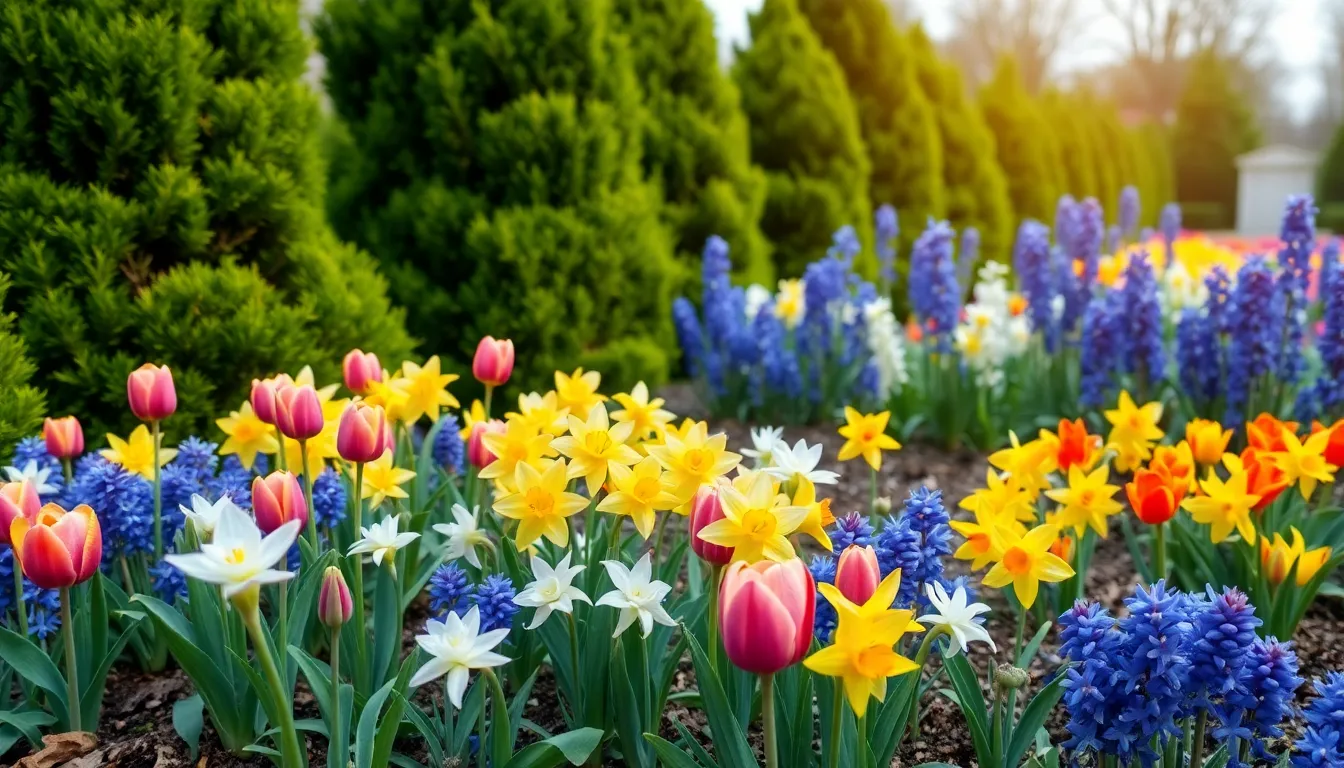
Creating a memorial garden that maintains beauty throughout every season ensures the space remains a meaningful place of remembrance regardless of when visitors arrive. Planning for year-round appeal transforms your memorial garden into a living tribute that evolves with nature’s cycles.
Include Spring Bulbs for Renewal
Spring bulbs offer the perfect beginning to your memorial garden’s seasonal journey, symbolizing renewal and new life after winter’s dormancy. Tulips create vibrant displays in colors ranging from soft pastels to bold reds, providing hope during the early months of spring. Daffodils bring cheerful yellow blooms that naturalize beautifully and return year after year with minimal care.
Hyacinths add fragrant purple, pink, or white flowers that create sensory memories through their sweet scent. Crocuses emerge first among spring bulbs, often pushing through snow to signal winter’s end. Plant bulbs in fall for spring blooms, choosing varieties that held special meaning to your loved one or simply creating colorful patches that bring joy to visitors.
Group bulbs in clusters rather than single plantings to create more dramatic visual impact. Select different bloom times among your spring bulbs to extend the flowering season from late winter through late spring.
Add Evergreen Plants for Winter Structure
Evergreen plants provide essential structure and visual interest when deciduous plants lose their leaves, ensuring your memorial garden remains beautiful throughout winter months. Boxwood creates formal hedges and can be shaped into meaningful forms while maintaining year-round green foliage. Rosemary offers aromatic evergreen leaves that visitors can touch to release fragrant oils, creating sensory connections to memories.
Pine trees establish vertical elements and provide shelter for wildlife while offering the soothing sound of wind through their needles. Holly bushes produce red berries in winter, adding color when most other plants remain dormant. Juniper varieties range from ground-hugging spreaders to upright specimens, offering options for different garden areas.
Position evergreens strategically to create backdrops for seasonal flowers and provide windbreaks for more delicate plants. Choose evergreens with different textures to create visual interest even without colorful blooms.
Plan Summer Blooms for Vibrant Color
Summer flowers bring peak color and activity to memorial gardens, attracting butterflies and pollinators that add life and movement to the space. Roses provide classic beauty and can be chosen for their symbolic meanings, with varieties available in colors that held special significance to your loved one. Sunflowers create bold statements with their cheerful faces that track the sun throughout the day, symbolizing warmth and positivity.
Lavender offers purple spikes and releases calming fragrance when brushed against, creating peaceful moments for reflection. Marigolds bloom continuously through summer heat and require minimal maintenance while providing bright orange and yellow colors. Zinnias attract butterflies and come in many colors, creating ever-changing displays that change throughout the growing season.
Plant summer flowers in succession to ensure continuous blooms from early summer through fall. Combine annuals and perennials to balance immediate impact with long-term garden establishment, creating layers of color and texture that evolve throughout the summer months.
Design Spaces for Reflection and Gathering
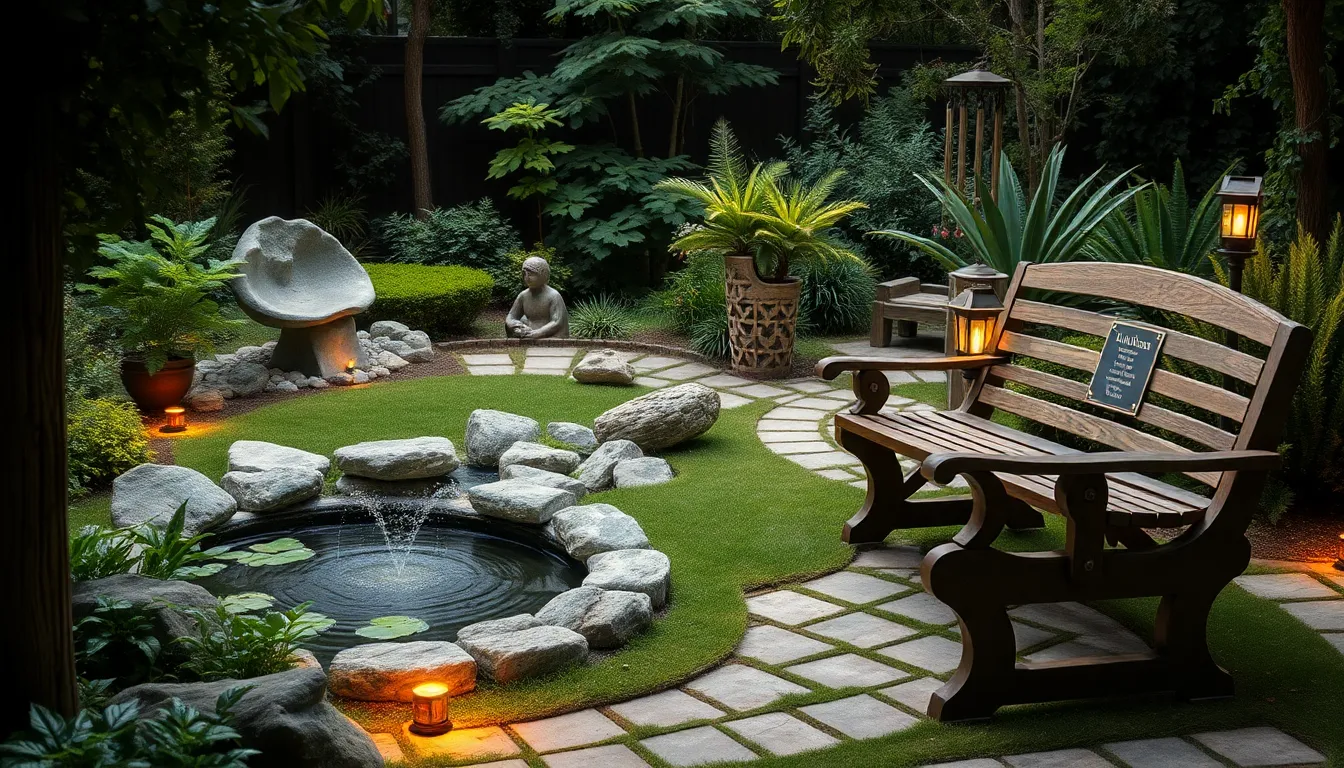
Thoughtful design transforms a memorial garden into a sanctuary where visitors can find peace and connection. Strategic placement of various elements creates an environment that encourages both solitude and meaningful gatherings.
Create Quiet Meditation Areas
Designing quiet spaces within your memorial garden requires careful attention to noise reduction and atmosphere creation. Dense foliage acts as a natural sound barrier, helping to minimize outside distractions while encouraging deep contemplation. Water features like small ponds or fountains provide gentle, soothing sounds that promote relaxation and mask any remaining background noise.
Garden art pieces such as sculptures or wind chimes add meaningful elements that reflect your loved one’s interests and hobbies. These personal touches create focal points for meditation while maintaining the peaceful ambiance essential for reflection. Position these quiet areas away from high traffic zones to ensure visitors can experience uninterrupted moments of remembrance.
Include Seating for Family Gatherings
Memorial benches serve as both functional seating and lasting tributes when equipped with plaques bearing special messages or meaningful quotes. These dedicated seating areas create natural gathering spots where families can share stories and memories together. Choose durable materials like teak or stone that withstand weather while maintaining their beauty over time.
Family gathering spaces work best when positioned in naturally shaded areas under trees or near water features. Consider creating multiple seating options including individual benches for quiet reflection and larger areas with grouped seating for family visits. Ensure these spaces accommodate visitors of all ages and mobility levels by maintaining clear pathways and comfortable access.
Add Lighting for Evening Visits
Solar powered lights illuminate pathways and highlight special garden features without disrupting the natural ambiance or requiring electrical connections. These energy efficient options automatically activate at dusk, creating a welcoming atmosphere for evening visitors while maintaining the garden’s serene character.
String lights hung between trees or along pergolas create warm, inviting spaces that encourage evening gatherings and reflection. Choose LED options with soft, warm color temperatures that complement the garden’s peaceful atmosphere. Position lighting to highlight memorial elements like benches, plaques, or special plantings while ensuring safe navigation throughout the garden space.
Consider Maintenance and Long-Term Care

Maintaining a memorial garden requires thoughtful planning to ensure it remains a beautiful tribute for years to come. We’ll explore strategies that minimize upkeep while maximizing the garden’s lasting impact.
Choose Low-Maintenance Plant Options
Low maintenance plants form the foundation of a sustainable memorial garden that thrives with minimal intervention. We recommend selecting trees and shrubs for their longevity and structural benefits, as they require less frequent care than annual flowers. Perennial varieties like daylilies, hostas, and lavender return each year without replanting, reducing both cost and effort over time.
Drought tolerant species significantly reduce watering requirements once established. Installing a drip irrigation system ensures efficient water delivery during dry spells, eliminating the guesswork of manual watering schedules. Native plants adapted to your local climate typically need less water, fertilizer, and pest control than exotic varieties.
Ground cover plants serve dual purposes by suppressing weeds naturally while filling spaces between larger plantings. Mulching around plants retains soil moisture and reduces weed growth, cutting maintenance time significantly. Choose plants with similar care requirements when grouping them together to streamline upkeep routines.
Plan for Seasonal Garden Care
Seasonal fertilizing supports plant health using organic fertilizers applied according to each plant’s exact needs and growth cycles. We suggest creating a calendar that outlines when to fertilize different plants throughout the year, ensuring optimal blooming and growth patterns. Spring feeding typically focuses on nitrogen rich fertilizers for new growth, while fall applications emphasize phosphorus and potassium for root development.
Pruning schedules vary by plant species and should align with their natural growth cycles for best results. Dead heading spent blooms encourages continued flowering throughout the growing season. Winter pruning of dormant trees and shrubs promotes healthy spring growth while maintaining desired shapes and sizes.
Weeding routines become more manageable when tackled regularly rather than waiting for major overgrowth. Hand pulling weeds after rain when soil is soft makes the task easier and more effective. Seasonal mulch applications in spring and fall create barriers that prevent new weed germination.
Establish a Care Schedule With Family
Family involvement creates shared responsibility and strengthens emotional connections to the memorial garden space. We recommend assigning exact garden areas to different family members, allowing each person to develop a personal relationship with particular plants or sections. This approach promotes community bonding while distributing maintenance tasks evenly.
Care schedules should outline exact responsibilities and timing for each family member’s contributions. Weekly tasks might include watering, deadheading, and light weeding, while monthly duties could involve pruning and fertilizing. Seasonal gatherings for major garden work like mulching or planting create opportunities for collective remembrance.
Communal events focused on garden maintenance foster unity while honoring your loved one’s memory. Organizing spring cleanup days or fall preparation sessions brings family together around a shared purpose. These gatherings often become cherished traditions that strengthen family bonds while ensuring the garden receives proper care throughout the year.
Conclusion
Creating a memorial garden offers us a meaningful way to transform our grief into something beautiful and lasting. Through thoughtful plant selection personal touches and carefully designed spaces we can create a sanctuary that truly honors our loved ones while providing comfort to those who visit.
The key lies in balancing practical considerations with emotional significance. When we choose low-maintenance plants incorporate personal remembrances and design accessible pathways we’re ensuring our memorial garden remains a cherished space for years to come.
Whether you’re planning a small corner garden or a larger dedicated area remember that the most important element is the love and intention behind each choice. Your memorial garden will become a living tribute where memories flourish and healing begins.
Frequently Asked Questions
What is a memorial garden and why should I create one?
A memorial garden is a dedicated outdoor space designed to honor and remember a loved one who has passed away. It transforms grief into a beautiful, living tribute that provides comfort and a peaceful place for reflection. These gardens serve as sacred spaces where memories can thrive through meaningful plants, features, and personal touches that reflect the spirit of your loved one.
Where should I locate my memorial garden?
Choose a quiet, private location away from high-traffic areas in your yard. Look for spots with natural barriers like trees or hedges that create intimacy and tranquility. Consider sunlight and soil conditions to ensure optimal plant growth, and make sure the area is accessible for visitors, including those with mobility challenges, with clear pathways and comfortable seating.
What types of plants work best in memorial gardens?
Select plants with personal meaning, such as your loved one’s favorite flowers or varieties that reflect their spirit. Perennials like daylilies, hostas, and lavender are ideal for lasting beauty and low maintenance. Consider fragrant herbs like rosemary and mint to create sensory connections to memories, and include seasonal options like spring bulbs and evergreens for year-round interest.
What features can I include as focal points in the garden?
Memorial benches, engraved stones, or plaques make meaningful focal points that encourage reflection. Water features like small ponds or fountains enhance the peaceful ambiance. Consider memorial trees as living tributes, garden ornaments that reflect your loved one’s personality, or designated areas for memory boxes where visitors can leave notes and mementos.
How do I design pathways and structure for the garden?
Create winding paths using natural materials like stone, wood, or brick to invite contemplation. Define garden borders with natural materials to maintain an organic feel while organizing different areas. Consider raised beds for easier maintenance and accessibility, and use dense foliage or natural barriers to create intimate meditation spaces within the larger garden design.
How can I ensure the garden looks beautiful throughout all seasons?
Plan for seasonal interest by including spring bulbs like tulips and daffodils, summer blooms such as roses and sunflowers, and evergreens for winter structure. Choose a mix of perennials that bloom at different times, and incorporate elements like ornamental grasses that provide texture year-round. This ensures your memorial garden remains vibrant and meaningful in every season.
What maintenance does a memorial garden require?
Choose low-maintenance plants like native species, drought-tolerant varieties, and ground cover to minimize upkeep. Create a seasonal care schedule for fertilizing, pruning, and weeding. Consider involving family members in the garden’s care by assigning specific areas or organizing communal maintenance events, which can strengthen bonds while honoring your loved one’s memory together.
How can I make the garden accessible for all visitors?
Design wide, stable pathways using materials like gravel or pavers for easy navigation. Include comfortable seating options like benches positioned in shaded areas. Consider raised beds that are easier to reach, and ensure adequate lighting for evening visits using solar-powered options. These features make the garden welcoming for visitors of all ages and physical abilities.

